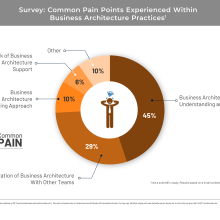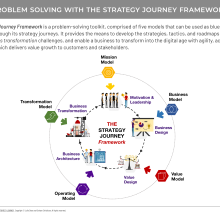Conversations with business architecture practitioners around the world and surveys such as the one below continually reveal that our top two challenges with business architecture pertain to creating understanding and buy-in for business architecture among other people as well as integrating the discipline with other teams and being relevant within a broader strategic business context. Business architecture has made tremendous strides as a business discipline and has reached a notable point of formalization and maturity. Business architecture is here and here to stay. But, we now must face these two challenges head-on.
So, we turned to an expert for some perspective, Julie Choo. StraightTalk author and long-time business architecture practitioner and global leader Whynde Kuehn interviewed Julie, author of THE STRATEGY JOURNEY book, creator of THE STRATEGY JOURNEY Framework, and founder of the Stratability Academy. Julie has spent over 20 years as a strategist, leader, and practitioner of business analysis and business architecture, continually working across the strategy journey and weaving business architecture into it.
In this installment of StraightTalk, we depart from your usual format to highlight 10 powerful takeaway messages from Julie Choo on how to practice the art of business architecture and bring focus on how the discipline fits within the broader context of the strategy journey.1
Make sure to watch the video conversation or listen to our full Fireside Chat podcast. It’s a must. The takeaways below are excerpted from the full-length conversation with Julie. The full conversation is pure gold and will expand your horizons, bring clarity, inspire, and give you new perspectives to share with others.
P.S. You might want to check out Posts No. 3, No. 50, and No. 83 for some grounding on business architecture + strategy execution as well as insights on how to work through some nuances.
10 Takeaways on the Art of Business Architecture and Its Role Within the Strategy Journey
Business architecture is a very, very important component of the strategy journey.
“The strategy journey as I have defined it in my book is comprised of 5 different stages. The first stage is motivation and leadership, the second stage is business design, followed by value design. Then, I have business architecture as an actual stage followed by business transformation. These five stages form a cycle that every organization goes through over and over.
What I want people to see is that there is a very, very important component which I have called business architecture within the fourth stage, which is where you pull it all together and work out what to do and what to change before you go away and execute the business change in the transformation phase.
Leading up to that are the other aspects of strategy which, in most cases, the business architect wouldn’t be responsible for ideating or constructing, but they would be responsible for validating and receiving information such as the actual business model, revenue targets, customers to serve, etc. A business architect brings all the information together about what the organization is trying to achieve and the value it is trying to deliver to customers and stakeholders and looks at how the operations and operating model of the organization fits to deliver all of those things – and also whether those things are correct or not.
So, business architecture and business architects are not focused on project management, delivery, or even creating a lot of the drawings, but rather work through what the problems and opportunities are and put them into different perspectives.”
Check out THE STRATEGY JOURNEY Framework from Julie’s book THE STRATEGY JOURNEY below.
The business architect role is not an easy role and I think that’s why it’s taken companies so long to understand the role and its place.
"Business architects have to be big picture, have the right perspectives, and be able to break it all down and support the execution work and builders. They have to be very open-minded to absorb all of this information, join the dots, look at all of the different perspectives, and actually still hold true to the purpose of the venture or project.
It’s not an easy role and I think that’s why it’s taken companies so long to understand the business architecture role and its place – and that’s why I put it in the fourth stage – the stage before you do the execution and transformation."
In it’s truest form, an operating model is what it takes to actually run the business.
“This includes an organization’s functions, capabilities, people, process, data, and technology. All of these things exist in isolation, but the operating model puts them all together to make it serve its purpose. A target operating model is simply what an organization should be doing at a future point in time.”
It’s important to be role agnostic.
“Business architecture is not necessarily just a role. It is something that a lot of different people in various different roles along the strategy journey would do or perform. I see business architecture as something that every organization should be living and breathing, which is why I have it as a full stage in the strategy journey. There may be people who have a specific title or role as a business architect, but actually, everybody in the organization, wherever they are, has a role to play.”
You have to empower business architects with the mandate to be able to say what they need to say and provide the right advice.
“If an organization has a central business architecture practice that manages the shared business perspectives and helps people make the right decisions about the way forward, it can put business architects in a challenging position because they become the middleman, the messenger, the person who pulls it all together – trying to be all things to all people.
For a central business architecture function to be effective, you have to empower business architects with the mandate to be able to say what they need to say and provide the right advice – agnostic of who likes it and who doesn’t like it. It doesn’t mean that the business architects are the ones who get to make the decisions, but they provide the strategy constructed in a certain way with the right perspectives and they give the organization and different stakeholder groups their optionality about how to proceed.
Business architects are probably the least powerful group because they don’t get to make any decisions. They make recommendations which may or may not be followed, but you still have to empower them and not put them in a position where their recommendations or data is compromised. Otherwise, this is ultimately at the detriment of the business because if you don’t have a function where you can always get the truth, the right data, and options to help you make your decisions, then you could be taking your organization and decision-making down the wrong path.”
Advice to an executive: If you want to be able to make the right decisions in your organization, you need a clear, open-minded, uncompromised source of truth.
“Business architecture can provide an objective source of truth and optionality to help senior management and C suite and the board to make the right decisions. If you have the role or mandate to support senior leaders, and you are that strategist or source of truth behind the scenes giving them the objective viewpoints and the data to help them make their decisions, it can be extremely rewarding. However, it requires you to be very open-minded, very good at looking at different perspectives, very good with data, and also have the personality and integrity not be comprised.”
Business architecture and project management have to work side-by-side.
“They will have natural tensions, and those tensions need to be accepted as being healthy. Both must be given equal footing to first, be able to execute with a level of adaptability and second, be a source of truth.”
To advance your business architecture career, consider what it is that you really want to achieve.
“Consider what’s important to you, whether it’s a title, a set of responsibilities, or certain things you want to do. You can practice elements of business architecture in almost every role. Figure out which aspects of business architecture fit in with what you enjoy doing, go away and work out where your best place is to add value, and then you go and do that role regardless of what it is called. And, know that if you are going to be successful in that role, there are elements of business architecture you will need to practice.”
If you are going to be a successful business architect, you need to understand where the economy and world are changing.
“This means that it is important to understand data and technology because they are the way the world is changing right now. Consider what people do, what needs, wants and problems they have in life, and what sorts of products or services can help them to create the life they want. This is always where the trends lead. We have to be in touch with what is possible and where things have evolved. It’s about being adaptable and keeping in touch with change.”
“If you are going to be effective in the role you play, you need to speak the language of the people you work with.”
“Whether you want to call it strategy or business architecture or digital transformation – you can call it whatever you want, but the important thing is to understand the context, the problems you are solving, and also the people that you work with.”
More Good Stuff...
The Strategy Journey (book by Julie Choo and Dr. Graham Christison): This is Julie’s book and it is a masterpiece. It’s a must-read for every business architecture practitioner as the answer to our greatest challenge and opportunity lies within it: how to understand, speak the language, integrate into, and deliver relevant value within the bigger picture context of business and its strategic journey.
The Stratabilty Academy: The Stratability Academy helps its students, clients, and partners to capture, produce, and deliver more value, by learning to transform and innovate better and faster today and into the future. Check out the site for training, resources, and more.
The Strategy Execution Metanoia: A New Approach for Translating Strategy Into Action with Business Architecture (S2E white paper): A foundational whitepaper that explores how business architecture can be leveraged as a means to an integrated business direction that is collectively architected, prioritized, and planned from a business-driven, enterprise-wide perspective.
Business Architecture-Enabled Strategy Execution (S2E diagram): A handy diagram for you to download on the role business architecture plays across strategy execution. It is the Cliff Notes version of the white paper above.
Leveraging Business Architecture: Translate Strategy Into Action (Cutter Webinar): An on-demand webinar (available to anyone) that explores an enterprise perspective on the strategy execution life cycle and the critical role business architecture plays throughout.
Enabling Strategy Execution: An Executive Perspective (Business Architecture Guild® webinar): A 10-minute video that articulates the role of business architecture in strategy execution, suitable to be shared directly with executives and other non-business architecture professionals.
Part 1, Section and 3.11, and Appendix B.1 of BIZBOK® Guide (Business Architecture Guild® membership required): The BIZBOK® Guide has some useful content on the role of business architecture in strategy execution.
The Elusive Link Between Technology and Strategy (by Dr. Brian Cameron in Biz Ed): An article by Dr. Brian Cameron, Associate Dean for Professional Graduate Programs in the Smeal College of Business at Penn State University and Special Academic Advisor to the Business Architecture Guild®. The article emphasizes the importance of effective strategy execution and strategic alignment – as well as the critical role that business architecture plays as an enabler. Furthermore, it represents an important step forward for business architecture in academia.
Dare to Disagree (TED Talk): A TED Talk by Margaret Heffernan on the importance of thinking partners that don't become echo chambers. “When we create conflict, we enable ourselves and the people around us to do our very best thinking.”
- 1NOTE: The content within this post has been synthesized from the StraightTalk Fireside Chat with Julie Choo and Whynde Kuehn, “Business Architecture and the Strategy Journey,” recorded on 13 January 2021. We’ve taken some liberty in this post to paraphrase and excerpt content, which may be sequenced differently than the original interview.


